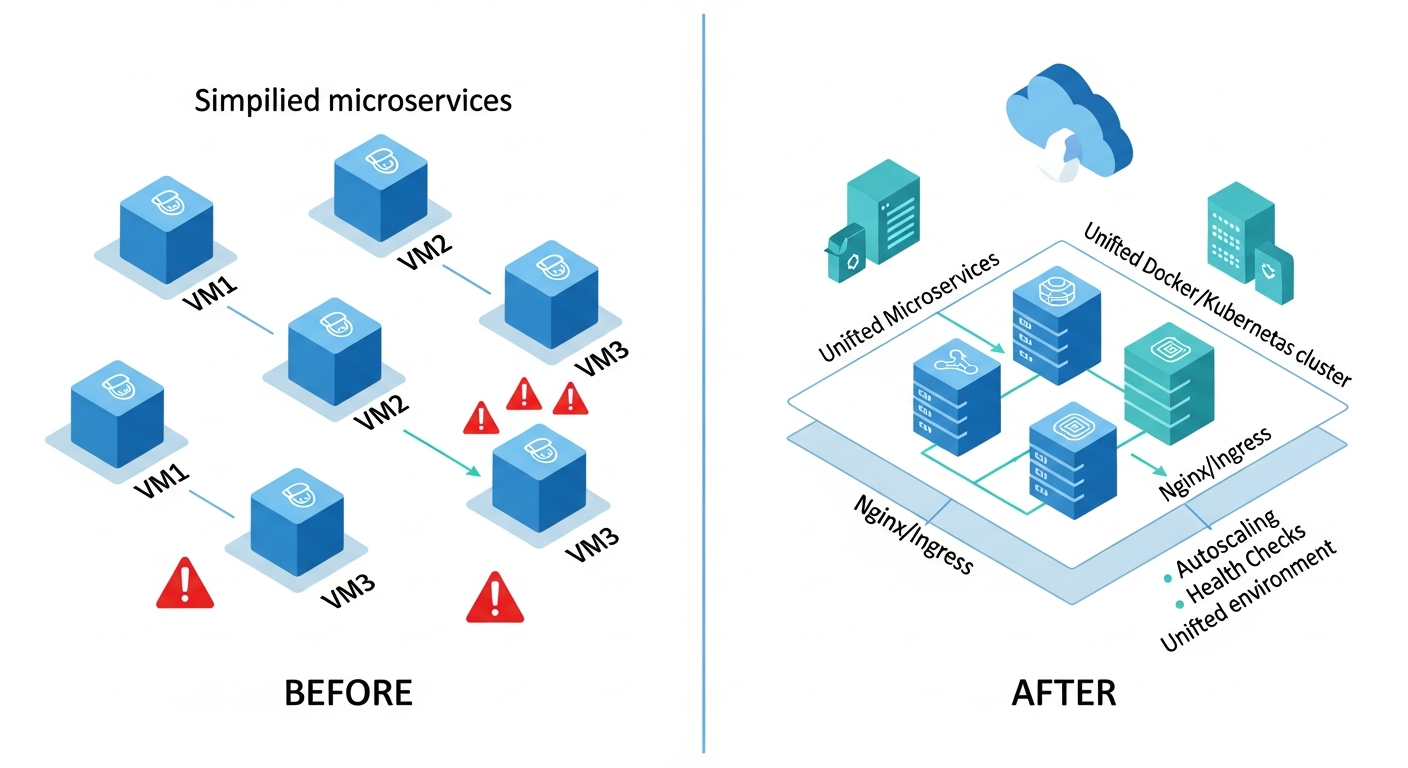Client
A technology company running 10+ microservices across several virtual machines. Each service had:
-
Separate environments
-
Different dependencies
-
Inconsistent OS settings
-
Frequent deployment issues
-
Long onboarding time for new developers
They wanted to modernize their deployment strategy and create a containerized, scalable microservice ecosystem.
Project Overview
The goal was to migrate the platform from:
❌ VM-based hosting
➡️ to
✔ Dockerized microservices with unified environments
✔ Optional orchestration via Docker Compose or Kubernetes
The new setup needed to:
-
Reduce setup time
-
Improve deployment speed
-
Simplify service scaling
-
Remove dependency conflicts
-
Provide a standardized environment
-
Work on cloud (AWS, Azure, GCP) or on-prem hosting
Key Challenges
1. Services on Different VMs with Different Stacks
Each VM had different:
-
OS versions
-
JDK versions
-
System libraries
-
Environment variables
Hard to debug. Hard to replicate.
2. Deployment Was Slow & Error-Prone
A deployment required:
-
Updating dependencies manually
-
Restarting services manually
-
Fixing OS-level mismatches
-
Long rollbacks
Downtime risk was high.
3. Developers Needed Days to Set Up Environment
New engineers spent 2–4 days configuring:
-
Tools
-
Dependencies
-
Database connections
-
Service configs
4. Scaling Was Manual
To scale a service:
-
A new VM had to be provisioned
-
Dependencies installed manually
-
Reverse proxy updated manually
Not efficient — especially during traffic spikes.
Our Solution
1. Containerizing Every Microservice
We created Dockerfiles for each service:
-
Java/Spring Boot services
-
Node.js services
-
Python services
-
Redis / Postgres / Nginx / Worker services
Optimizations included:
-
Multi-stage builds
-
Minimal base images
-
Reproducible builds
-
Environment variables via
.envor secrets manager
Result:
Every service now runs consistently, anywhere.
2. Replacing VM Deployments with Docker Compose
For environments without Kubernetes (staging/dev), we built a Docker Compose stack:
Benefits:
-
One command to start entire platform
-
Local environment identical to production
-
Easier debugging & logs
-
No dependency conflicts
3. Kubernetes for Production-Grade Scaling
For environments requiring high scalability, we deployed services to a K8s cluster (EKS, AKS, or GKE):
-
Deployment & StatefulSet configs
-
Horizontal Pod Autoscaling
-
Liveness/Readiness probes
-
ConfigMaps & Secrets
-
Nginx Ingress or Traefik
-
Observability with Prometheus/Grafana
Kubernetes enabled:
-
Automatic scaling
-
Zero-downtime updates
-
Self-healing pods
-
Simplified rollback
4. CI/CD Integration
We integrated Docker builds into CI/CD pipelines:
-
GitHub Actions
-
GitLab CI
-
Jenkins
-
Bitbucket Pipelines
Pipeline included:
-
Build Docker image
-
Run tests
-
Push to registry
-
Deploy to Compose/K8s
This made deployment:
-
Faster
-
Consistent
-
Automated
5. Centralized Reverse Proxy & SSL Termination
Migrated routing from per-VM configs to:
-
Nginx or Traefik in Docker
-
ACME SSL auto-renewal
-
Centralized API gateway
Consistent routing for all environments.
Architecture Before & After
Before (VM Based):
After (Docker / Kubernetes):
Results & Impact
⚡ Onboarding Time Reduced by 80%
From 3 days → 4 hours
Developers now run everything with a single command.
🚀 Deployment Time Reduced by 70%
No manual VM login, no OS conflicts, no setup delays.
📦 Consistent Environments
Same Docker images run across:
-
Dev
-
QA
-
Stage
-
Production
“No more it works on my machine problems.”
🌐 Simplified Scaling
Docker/K8s allowed:
-
Horizontal scaling automatically
-
Adding instances in seconds
-
No manual VM provisioning
🛡 Fewer Errors & Downtime
Monitoring + health checks =
self-healing containers & zero-downtime updates.
💰 Cost Savings
Shutting down multiple VMs → running efficient containers → lower compute cost.
Conclusion
By transforming the client’s VM-based microservice platform into a containerized, Docker-powered architecture, we delivered:
-
Faster onboarding
-
Consistent environments
-
Automated deployment
-
Easy scaling
-
Reduced operational complexity
-
A modern cloud-native foundation
This upgrade makes the client’s platform future-ready and easier to maintain as services grow.

Written by
Oliver Thomas
Oliver Thomas is a passionate developer and tech writer. He crafts innovative solutions and shares insightful tech content with clarity and enthusiasm.




